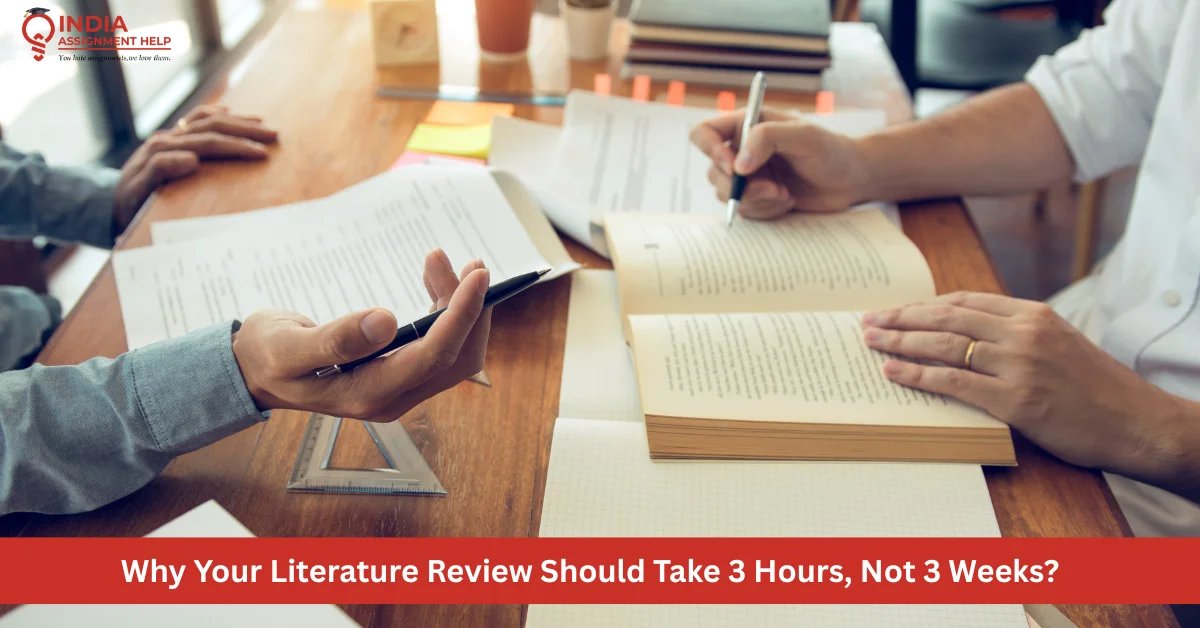Why Your Literature Review Should Take 3 Hours, Not 3 Weeks?

Hello, future researchers, busy students, and anyone who's ever felt swallowed by a mountain of academic papers!
Let’s be honest: the literature review is often the scariest part of a thesis, dissertation, or major academic research paper. It’s where you have to prove you’ve read everything, understood it all, and know exactly how your tiny piece of research fits into the giant academic puzzle. This process often leads to days of panicked reading and weeks of writer’s block.
If the thought of conducting a proper literature review in research makes you want to hide under your desk, I have good news. In today’s world, spending three weeks reading every single article cover-to-cover is no longer the smartest way to work.
Let’s learn how to use focus, strategy, and a little bit of AI magic to make your next literature review efficient, insightful, and surprisingly fast.
Part 1: Deconstructing the "Lit Review" (What It Really Is)
Before we can be fast, we must be smart. A literature review is not just a book report on articles. It's a critical, organized discussion that lays the foundation for your study.
The Core Purpose of the Literature Review
The purpose of the literature review is fundamental to your entire research methodology. You are trying to achieve three main things:
- Define the Battlefield: You establish what is known about your topic, defining key terms and theories. You show the reader you are an expert in the area.
- Find the Gaps: You identify the areas where previous studies stopped. These are the contradictions, the unanswered questions, or the missing data. This is often called the research gap or research problem.
- Justify Your Existence: You use the gap to prove why your specific study is necessary. If everything has been done, why are you doing this research?
Key Takeaway: Synthesis, Not Summary
The number one mistake students make is just summarizing one paper after another: "Smith (2020) said this. Then Jones (2021) said that."
A professional literature review in research must synthesize. Synthesis means comparing and connecting ideas. You should be telling the reader: "Most studies agree that (Idea X) is important (Smith, 2020; Jones, 2021), but a major debate exists regarding the best way to measure it (Lee, 2022; Chen, 2023)."
This shift in focus is what moves your work from a C grade to an A, and it’s the key to speeding up the writing process.
Part 2: The Time-Saving Tactic: AI and the 3-Hour Mindset
The secret to moving from weeks to hours is a focused, three-stage workflow. You must use modern AI software and tools to handle the tedious initial steps.
The 3-Hour Breakdown (Drafting Only)

Signify the Use of AI Software: Your Research Assistants
Instead of spending weeks in a library, you now have powerful virtual assistants that can help you find, read, and organize information faster than ever.
Here are a few AI software and tools that leading researchers are using to streamline the literature review process:
- Elicit: Think of Elicit as an AI research helper. You ask it a research question, and it quickly finds relevant academic papers and summarizes the abstract and main findings into a single, easy-to-read table. This drastically speeds up Stage 1 of your search.

- Semantic Scholar: This free website uses AI to highlight the most influential papers on a topic and identify which papers have been cited the most. This helps you skip irrelevant sources and focus on the "must-read" foundational research.

- Research Rabbit: This fantastic tool works by citation network mapping. You put in one or two good papers, and it visually maps out all the related research, showing you earlier foundational work and newer, highly-cited papers.

- SciSpace (formerly Typeset): This tool offers AI-powered research summarization. It can often provide a concise "TL;DR" (Too Long; Didn’t Read) text and summaries for long research articles, saving you hours of initial reading time.

- Zotero / Mendeley (Citation Management Software): These are essential, non-negotiable tools. They automatically save the full citation details (Author, Year, Journal) as you find a source and generate your reference list instantly. Using these ensures your paper is Turnitin safe from a citation standpoint and helps you avoid missed references.

Part 3: How to Write a Literature Review
The key to a 3-hour draft is a great literature review format. You need a strong, analytical structure before you start writing.
The Standard Three-Part Structure
Like any academic essay, your literature review will have three main parts:
- Introduction:
- State your topic and its background.
- Define the scope (what literature you included/excluded).
- State the purpose of the literature review—which is to identify the main themes, debates, and the research gap you will address.
- Signposting: Tell the reader your thematic structure (e.g., "This review is organized around three main themes: technological barriers, psychological readiness, and organizational culture.")
- Main Body (The Analysis):
- This is where you organize your discussion based on ideas, not authors.
- Each section should represent a major theme, debate, or methodological issue you identified.
- This is where you show the different types of literature review organization in practice (Thematic, Methodological, or Theoretical).
- Conclusion:
- Summarize the main consensus and contradictions you found in the literature.
- Reiterate the central research gap you have found.
- Conclude by explaining how your specific study and its research methodology will be the one to address that missing piece of knowledge.
Types of Literature Review Organization (Your Structure Choices)
How you structure the Main Body sections dictates the speed and quality of your analysis:
- Thematic Review (Recommended for Speed): This groups your discussion by sub-topics or themes. This is often the most effective for undergraduate and master’s level work.
- Example Section: "The Impact of Leadership Style on Team Performance." You then discuss every paper that relates to this theme in the same section, noting their agreements and disagreements.
- Methodological Review: You group studies based on the research methods they used (e.g., all studies using quantitative surveys in one section, all qualitative interviews in another).
- Theoretical Review: You group studies based on the theories or models they tested. This is particularly useful if your research focuses on testing or combining established theories.
Part 4: Writing the Draft and Staying Turnitin Safe
Once your outline is complete, the writing phase is simply connecting the dots.
90 Minutes to a Human-Written Draft
- Write from your Outline: Use the notes and summaries you gathered in Stage 1 and structured in Stage 2. Your job is now that of a masterful connector and analyst.
- Focus on Arguments, Not Authors: Every paragraph should start with a core idea, not an author's name.
- Bad: Smith (2020) studied X and found Y.
- Good: Despite widespread consensus on X, the role of Y remains highly debated (Smith, 2020; Johnson, 2022; Chen, 2023).
- Use Proximity Rules: Ensure your core keywords (literature review, research methodology, purpose of the literature review) appear naturally near key concepts in your introduction and conclusion to satisfy both your reader and search engines (for SEO).
- Insert Citations Immediately: Do not save referencing for the end! Use your Zotero or Mendeley software to insert the citation as soon as you type the information. This habit saves countless hours and prevents accidental plagiarism.
Ensuring Your Work is Turnitin Safe
The biggest worry with speed drafting is academic integrity. Remember: AI software helps you find and understand sources; you write the critical analysis.
Your work will be Turnitin safe because:
- You are Citing Everything: Using citation software and immediately citing every claim prevents accidental plagiarism.
- Your Voice is Unique: Turnitin excels at finding large blocks of unoriginal text. Your literature review is a highly analytical piece, focusing on your interpretation of how various sources relate to each other.
- You've Used Primary Sources: AI tools lead you to the original journal articles. Your final draft is based on those high-quality, peer-reviewed sources, not low-quality internet summaries.
Conclusion
The idea that a solid literature review requires weeks of manual labor is a relic of the pre-digital age. Today, a literature review in research is about efficiency and critical focus.
By defining a sharp research question, leveraging AI software and tools to gather and summarize (Stage 1) rapidly, meticulously structuring your argument by theme (Stage 2), and focusing your writing time purely on analysis and synthesis (Stage 3), you can produce a superior, Turnitin-safe document in hours.
Stop reading linearly. Start thinking thematically. Reclaim your time and make your next literature review fast and a demonstration of strategic genius. If you need help, connect with our academic experts at India Assignment Help and learn how to master the 3-hour literature review.





